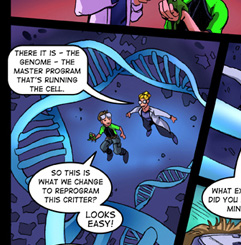In my work I write about nanotechnology and synthetic biology and over the next couple of weeks I would like to describe what is happening in these high technology fields. I start with synthetic biology. I am not a scientist and cannot give any form of technical description of how they do what they do. I can present a kind of sketch though of what they are doing and their aims.
The first question then must be what is synthetic biology? Well it is something that can be described as engineering, biology, genetics or nanotechnology, the most common description is that of applying the concept of engineering to biological organisms. But what does that actually mean?
Well, synthetic biology aims to design and engineer biologically based parts, novel devices and systems as well as redesigning existing, natural biological systems. Practitioners use a systems approach, an organism is seen as a whole, or a system, and can therefore be engineered, very much like a machine.
The system is reduced to biological parts (bioparts) whose function is expressed in terms of input/output characteristics. Once these parts have been described in terms of their function, isolated, standardised and syntheticaly reproduced, they can then be combined to from new organisms, very much in the way that an engineer would build a machine using standard devices built from standard parts. It is just that they are parts of a living organism.
These standard parts are defined by their DNA, and this can be manipulated in order to make the perfect part for the perfect device. Parts of the DNA can be removed and synthetic pieces used to replace them. Create the right part that does the right job, put in it a carrier cell (known as chassis) and Bob’s your Uncle, you can start to construct your organism.
The Biobricks Foundation is a not for profit organization that aims to keep a register of these standard parts, maintaining open access and promoting technical standardization, something that is seen as holding the key to the further development of synthetic biology.
Obviously to do all of the above you require technical expertise, the process requires computational modeling in order to analyze the complexities of biological entities and to predict system performance. You require DNA sequencing in order to describe the genome and then of course DNA synthesis, to re-produce either part of or the entire genome itself.
But what are the potential areas of application for this technology, and what can they actually do now?
One of the main fields is undoubtedly medicine. Drugs can be produced that are more effective or have fewer or even no side effects, as the genomes of their active components can be adjusted and synthesized. An example is the development of a synthetic version of the anti-malarial drug Artermisinin that could be industrially and cheaply mass produced, and in the near future antibiotics could become much more efficient.
Another existing application is water that changes colour when in contact with different polluting agents making them instantly recognizable. Switches already exist that react to certain types of input. An example could be a cell that is part of a person’s body that reacts to the stimulus of a certain chemical that in turn stimulates the production of another. Imagine for example a device that reacts to a chemical produced by a cancerous cell. This input causes a reaction that produces another chemical to counteract this presence. All working naturally using the body’s energy to function.
Other developments involve the energy sector, the production of plants for bio mass that are not as wasteful as those used today and even the development of synthetic aviation fuels.
In other fields a synthetic form of the silk produced by the Golden Orb spider is under development. This is an extremely strong, fine and lightweight material that could lead the way towards new specialist engineering materials.
They are even working on living computer memory, and this article describes breakthroughs and results in DNA computing.
Well this is nothing but reasonable, my memory lives in my brain and the memory of my ancestors in my DNA, and now they have the technology to read it and even change it, so why not use it in a computer?
I have written several articles on this and other related topics on the Bassetti Foundation website, and as I said I am no scientist, so all comments and criticism invited and accepted.

4 thoughts on “What is Synthetic Biology?”